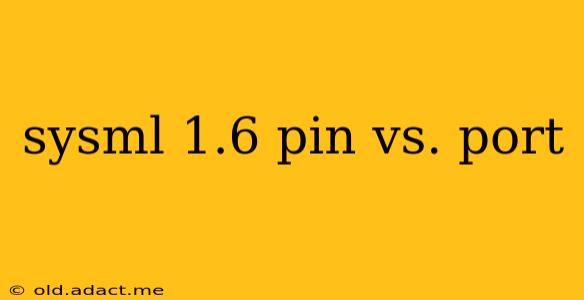System Modeling Language (SysML) is a powerful tool for systems engineering, allowing modelers to create comprehensive representations of complex systems. Within SysML 1.6, two key concepts often cause confusion: pins and ports. While both represent interaction points, they serve distinct purposes and have crucial differences in their application. This article will clarify the distinctions, helping you effectively utilize these elements in your SysML models.
What are Pins in SysML?
Pins are primarily used to represent the data flow in interaction diagrams, such as sequence diagrams and activity diagrams. They depict the individual data items exchanged between elements during an interaction. Think of them as the specific pieces of information passing across a communication channel. Pins are typically associated with specific operations or actions, clearly showing what data is input or output. They represent a specific data value at a point in time during the interaction.
Key Characteristics of Pins:
- Data-centric: Their core function is to model data exchange.
- Interaction-specific: They exist within the context of a specific interaction.
- One-time use: A pin represents a single data value passed during a single interaction.
- No inherent structure: Pins don't have internal structure or properties. They simply represent the data being transferred.
What are Ports in SysML?
Ports, in contrast, represent the interaction points of a block (a component or system within your model). They define the interfaces through which a block interacts with its environment or other blocks. Think of them as the connectors or sockets on a device – they define what kinds of interactions are possible, but not the specifics of each interaction.
Key Characteristics of Ports:
- Interface-centric: Their role is to define what interactions a block can participate in.
- Block-specific: They are associated with a specific block and are part of its definition.
- Reusable: A port can participate in multiple interactions.
- Structured: Ports can have properties, including data types, multiplicity (how many connections are allowed), and even sub-ports. They can be used to define the overall type of interaction (e.g., a data port, a flow port, or a service port).
Pins vs. Ports: A Clear Distinction
The fundamental difference lies in their level of abstraction and purpose:
- Pins are low-level, data-focused elements used to illustrate data flow within interactions.
- Ports are high-level, interface-focused elements used to define interaction capabilities of a block.
You can visualize it this way: Ports define the sockets, and pins represent the data plugs that fit into those sockets during a specific interaction. A single port can have many pins associated with it across different interactions.
How to choose between Pins and Ports?
The selection depends on the modeling context:
- Use pins when detailing the data flow in an interaction diagram. Show precisely what data is exchanged between elements during a specific operation.
- Use ports when defining the interaction capabilities of a block in a block definition diagram. Show what kind of interactions the block can participate in.
Frequently Asked Questions (FAQ)
Can a port have multiple pins?
Yes, a single port can have many pins associated with it across different interactions. Each interaction using that port might have different data being passed (represented by different pins).
Are ports always visible in interaction diagrams?
No. Ports might be implicitly used in an interaction diagram, while the focus is on the specific data flow represented by the pins. However, the context of the ports is implied by the blocks involved in the interaction.
Can I use both pins and ports in the same model?
Absolutely! This is often best practice. Ports define the general interaction capabilities of blocks, while pins detail the specific data flow during specific interactions. Using both gives a comprehensive understanding of the system's behavior.
Are there different types of Ports?
Yes, SysML allows for different kinds of ports, such as data ports, flow ports, and service ports, each with specific characteristics and behaviors. The type of port used depends on the nature of the interaction it represents.
By understanding the distinctions between pins and ports in SysML 1.6, you can build more precise, comprehensive, and easily understood system models, leading to improved communication and collaboration throughout the systems engineering process.
